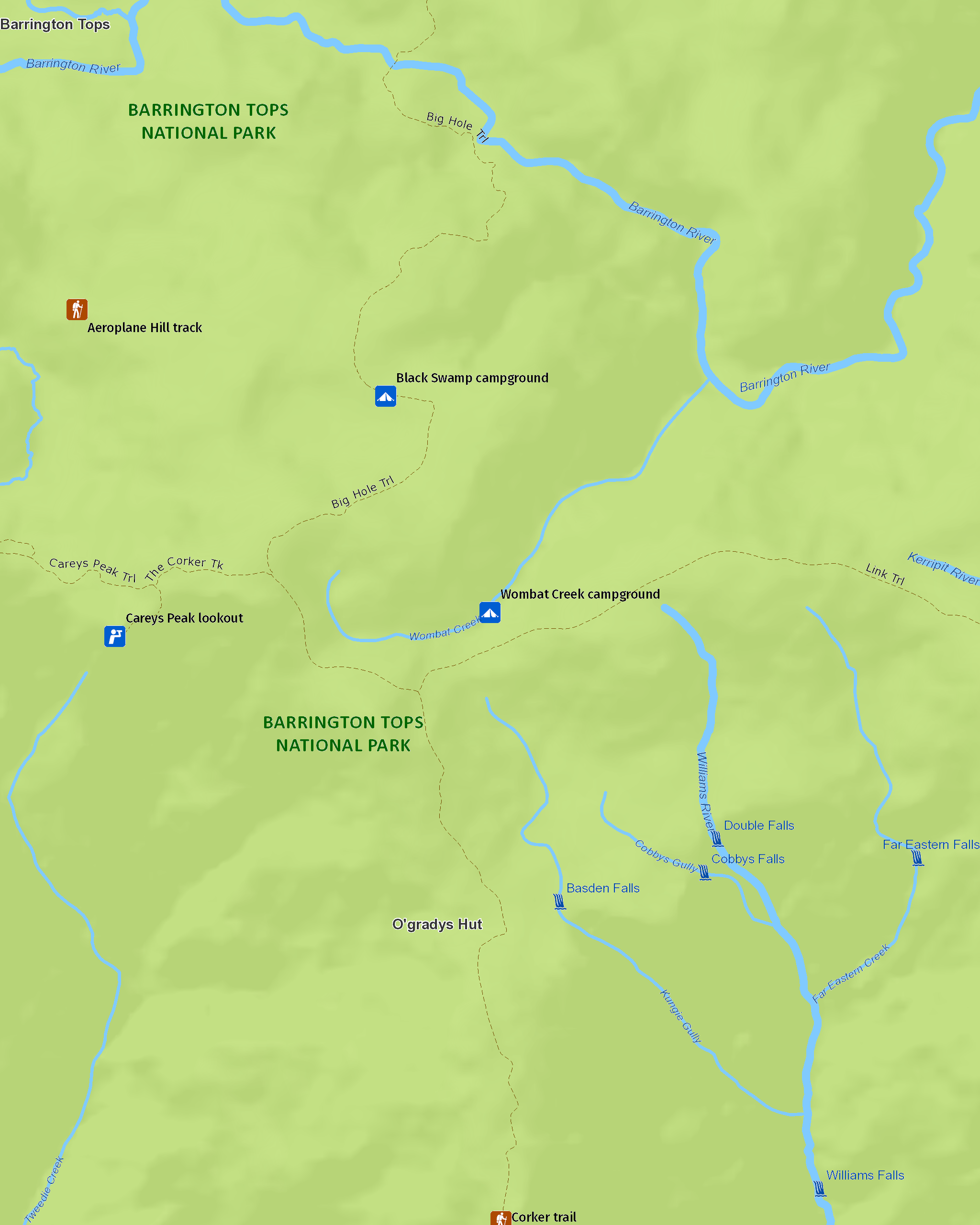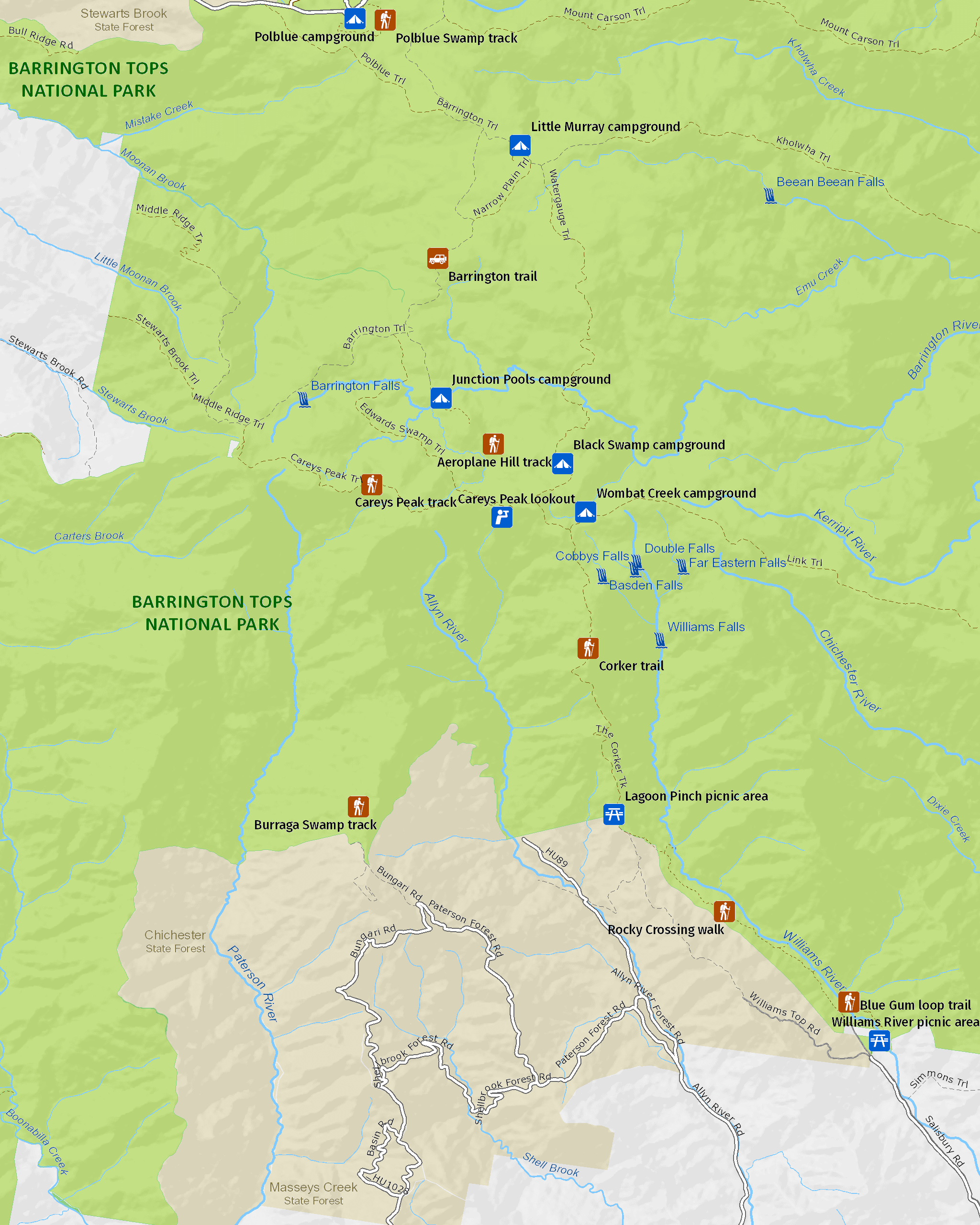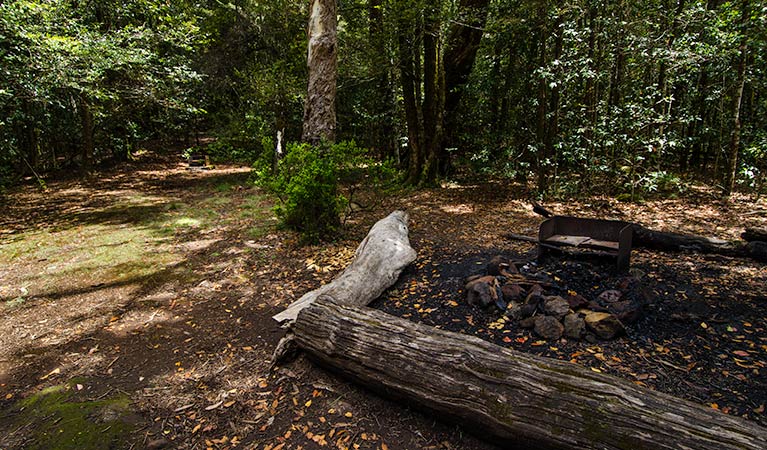Wombat Creek campground
Barrington Tops National Park
Overview
Walk-in rustic Wombat Creek campground offers walking, wildlife, and wilderness in the sub-alpine region of World Heritage-listed Barrington Tops National Park, between Gloucester and Dungog.
| Number of campsites | 5 |
|---|---|
| Camping type | Tent, Remote/backpack camping |
| Facilities | Barbecue facilities, toilets |
| What to bring | Firewood, fuel stove |
| Price | There are no camping fees at this campground but a $6 booking fee applies. |
| Bookings | Book up to 12 people or 2 sites online. |
| Group bookings | School groups and Park Eco Pass holders can make a group booking enquiry. |
| Please note |
|
When you’re ready for a night under the stars, make tracks to walk-in Wombat Creek campground, high in the remote wilderness of Barrington Tops National Park. Due to its isolation, this unique, sub-alpine region is habitat for a range of rare and endangered species; have fun spotting these.
You’ll be ready to take a load off and boil the billy when you arrive. Only accessed by walking track, there’s a more leisurely path via Careys Peak lookout or the more challenging Corker trail. Either way, this rustic camping spot makes a great base to explore this wild wonderland.
At night, cook up a feast fit for all the bushrangers who’ve hidden out in these wild hills over the years. Go spotlighting for a chance to see possums as well as greater gliders, wombats, and bandicoots.
Map

Map

Map legend

Local alerts
For the latest updates on fires, closures and other alerts in this area, see https://www.nationalparks.nsw.gov.au/camping-and-accommodation/campgrounds/wombat-creek-campground/local-alerts
Bookings
- National Parks Contact Centre
- 7am to 7pm daily
- 1300 072 757 (13000 PARKS) for the cost of a local call within Australia excluding mobiles
- parks.info@environment.nsw.gov.au
Operated by
- Gloucester office
- Monday to Friday, 8.30am to 4.30pm.
- 02 6538 5300
- npws.barringtontops@environment.nsw.gov.au
- 59 Church Street, Gloucester NSW 2422
Park info
- in Barrington Tops National Park in the North Coast and Country NSW regions
Barrington Tops National Park is always open but may have to close at times due to poor weather or fire danger.
Visitor info
All the practical information you need to know about Wombat Creek campground.
Maps and downloads
Learn more
Wombat Creek campground is in Barrington Tops National Park. Here are just some of the reasons why this park is special:
World Heritage-listed rainforests

The rainforests in Barrington Tops National Park are part of the Gondwana Rainforests of Australia World Heritage Area; the most extensive strip of diverse rainforest anywhere on earth. The World Heritage Area is a direct window into the past and the future, providing a link to the ancient pre-human world and a stunning and irreplaceable record of life on our planet. You can explore the rainforest on one of the park's many walking tracks, like the Honeysuckle Forest track, the Rocky Crossing walk or the Antarctic Beech Forest track. Listen out for the lyrebird whose mimicking calls ring out through the rainforest.
- Antarctic Beech Forest walking track Antarctic Beech Forest walking track offers rainforest, cascades, scenic views, and birdwatching in Barrington Tops National Park, near Gloucester.
- Barrington Tops guided full-day hike Join Endless Adventure Travel on a full-day guided hike in Barrington Tops National Park. You’ll walk 17km through lush ancient rainforest with stunning cascade waterfalls.
- Careys Peak walking track Easy Careys Peak walking track offers picnicking, scenic views, birdwatching, and historic heritage in the sub-alpine region of Barrington National Park, near Scone.
- Cobark Park picnic area Take a break at Cobark Park picnic area to plan your adventures in the plateau region of Barrington Tops National Park—1 hour from Gloucester.
An ancient landscape

Barrington Tops National Park and the adjoining State Conservation Area are the traditional lands of Biripi, Worimi, Guringai, Geawegal and Wonaruah People. The rainforests of Barrington Tops offered a wealth of resources for Aboriginal people, including many edible fruits, like the native cherry, lilly pilly and figs. Today, the history of Aboriginal people in Barrington Tops is recorded in oral history and in the presence of Aboriginal sites. Barrington Tops National Park protects ancient campsites, scarred trees and sacred ceremonial places.
A dramatic wilderness

Most of Barrington Tops National Park is declared wilderness; large, natural areas of land that, together with their native plants and animal communities, remain essentially unchanged by modern human activity. Wilderness areas in NSW represent the largest, most pristine natural areas within NSW - the last of Australia's wild and untamed places. The edges of the wilderness area of Barrington Tops are easily accessible; some of the most spectacular views in the park are from Careys Peak and Devils Hole and Thunderbolts lookouts. You'll notice the varied textures of the forest below you, with the ranges of the Barrington Wilderness running east and south from the plateau like the fingers of an outstretched hand.
- Barrington trail Take the challenge of the Barrington trail, a 4WD trail in Barrington Tops National Park. Open between October and May every year, plan your 4WD camping holiday now.
- Gloucester Tops circuit Walk through snow gum woodland and ancient rainforest to lookouts and waterfalls, along the Gloucester Tops circuit. This 8km loop combines 3 popular and scenic walks in Barrington Tops National Park.
- Majestic Barrington mountain bike tours Enjoy spectacular scenery as you cycle through Barrington Tops National Park and beyond on this supported mountain bike tour with Aussie Bike or Hike, near Gloucester.
- Rocky Crossing walk Rocky Crossing walk along Williams River offers scenic rainforest views, wildlife and birdwatching on a long easy track in Barrington Tops National Park, near Dungog.
Plants and animals protected in this park
Animals
-

Superb lyrebird (Menura novaehollandiae)
With a complex mimicking call and an elaborate courtship dance to match, the superb lyrebird is one of the most spectacular Australian animals. A bird watching must-see, the superb lyrebird can be found in rainforests and wet woodlands across eastern NSW and Victoria.
-

Swamp wallaby (Wallabia bicolor)
The swamp wallaby, also known as the black wallaby or black pademelon, lives in the dense understorey of rainforests, woodlands and dry sclerophyll forest along eastern Australia. This unique Australian macropod has a dark black-grey coat with a distinctive light-coloured cheek stripe.
-

Bare-nosed wombat (Vombatus ursinus)
A large, squat marsupial, the Australian bare-nosed wombat is a burrowing mammal found in coastal forests and mountain ranges across NSW and Victoria. The only other remaining species of wombat in NSW, the endangered southern hairy-nosed wombat, was considered extinct until relatively recently.
-

Australian brush turkey (Alectura lathami)
The Australian brush turkey, also known as bush or scrub turkey, can be found in rainforests along eastern NSW. With a striking red head, blue-black plumage and booming call, these distinctive Australian birds are easy to spot while bird watching in several NSW national parks.
-

Common ringtail possum (Pseudocheirus peregrinus)
Commonly found in forests, woodlands and leafy gardens across eastern NSW, the Australian ringtail possum is a tree-dwelling marsupial. With a powerful tail perfectly adapted to grasp objects, it forages in trees for eucalypt leaves, flowers and fruit.
-

Rufous scrub-bird (Atrichornis rufescens)
The vulnerable rufous scrub-bird is a small, ground-foraging bird that lives only in isolated rainforest areas of south-eastern Australia.

